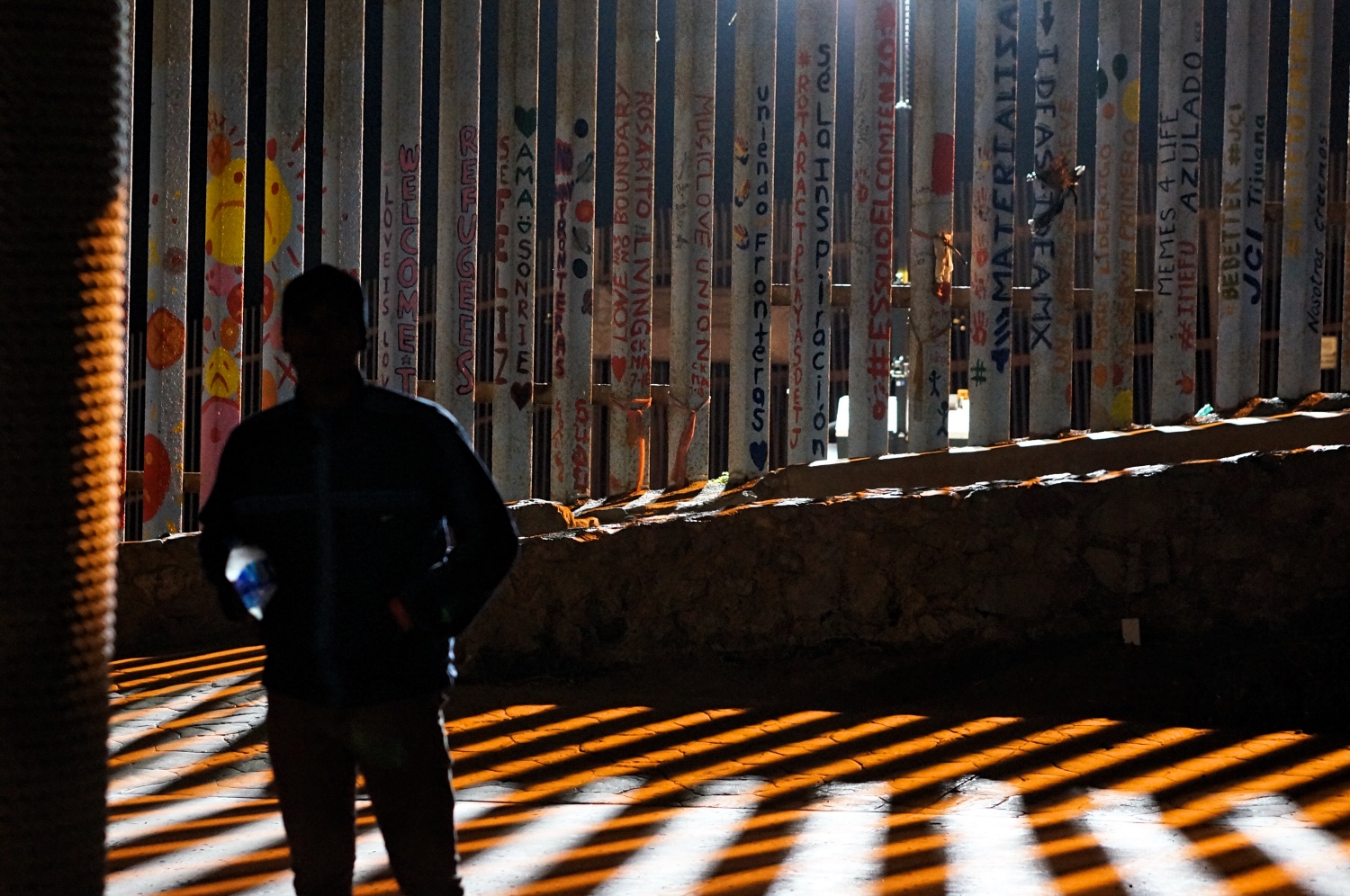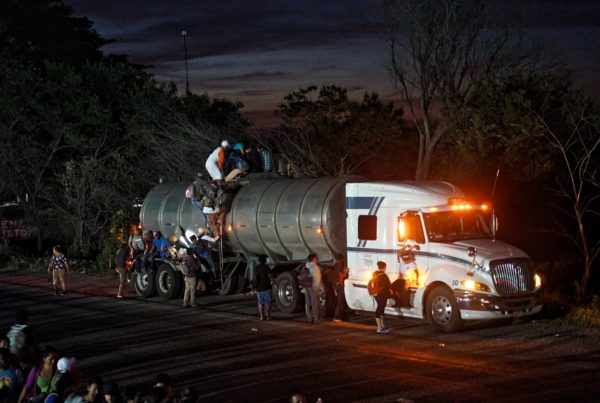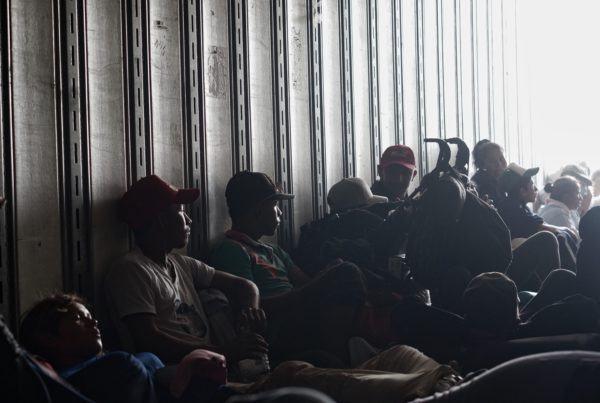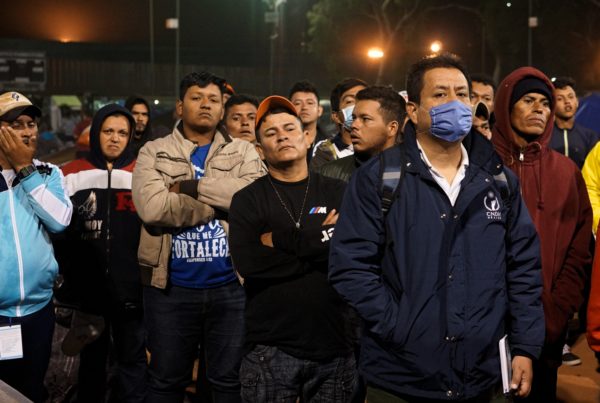It’s a cold night at Las Playas de Tijuana, made worse by a coastal wind which finds gaps in clothing. The border wall which separates Mexico and USA is illuminated orange by high-powered flood lights. The wall is an ugly, distinctly unnatural structure. A monument to prejudice, isolationism, fear and hatred. Strange, angled, rusty brown steel fence palings with gaps between them allow those on the Mexican side of the border to peak into the USA.
The rumour in the migrant caravan is that people are planning to jump the wall this evening. It looks a difficult task. At some points the wall is topped by rusted steel sheets which try to prevent people from climbing over. At other points there is hurricane wire. Perhaps they will climb the palm trees that line the wall.
At Tijuana Beach, the wall is covered in messages of protest.
“Love trumps hate.”
“Freedom is nothing but a chance to be a better human.”
“The Wall of Brotherhood.”
I wait in the shadows and scrub not far from Tijuana’s lighthouse until a group of people emerge from the dark undergrowth nearby.
In the group, there are a few young men in their twenties, three women, an older man and his teenage daughter.
“Five hundred people will jump tonight. If we do it together the border authorities will have trouble catching everyone. It’s safety in numbers,” one of the young men named Juan explains in perfect English.
Juan clearly has some authority within the group. The other migrants ask him about plans for the evening and he hands out money to buy food and drink. He explains that they will not jump at this exact location. They will find a “black spot” on the wall. Once they are over the wall, they will split and run. He thinks it should take an hour to San Diego. I am not so sure. From our vantage point near the Tijuana lighthouse, we can see the twinkling lights of San Diego in the distance. For the time being, the group is waiting for the signal to cross.
The United States first began installation of a wall in 1993, when President Bill Clinton mandated the 14-mile “Border Wall” along a line in the sand between San Diego and Tijuana to prevent drug trafficking and undocumented immigration. Since then, the US has spent billions of dollars building and monitoring border walls.
“The Wall” is not one continuous structure and it doesn’t cover the whole of the 3,145 km border between the United States and Mexico. Rather it is a series of walls and fences constructed in urban and uninhabited areas where the most concentrated numbers of illegal crossings and drug trafficking occur. There are long stretches of border that have no physical barrier, the longest of which is more than 600 miles. As of August 2017, 705 miles only had pedestrian fencing or vehicle fencing. A system of sensors and cameras monitored by the United States Border Patrol has also created a “virtual” fence.
Although the border walls are a physical impediment to drug traffickers and undocumented migrants, there is no clear evidence that these walls are successful deterrents. Instead, border walls have pushed undocumented migrants into more dangerous routes, often involving criminal networks and smugglers, to reach US territory which has increased the number of deaths as a consequence. In the years after securing parts of the US-Mexico border, there was a decline in deaths in California which coincided with a rapid rise in Arizona. What’s more, most illicit drugs are smuggled into the United States through legal ports of entry.
Trump’s pledge to build a further 1000-miles of wall will cost the American people anywhere between US$21 billion – $70 billion depending on whether you use an internal report from the Department of Homeland Security or a report by Senate Democrats.
A better way to stem the future flow of undocumented migrants might be to address the reasons why people are leaving Central America in the first place. Perhaps Trump could re-examine US foreign policy in Central America. Ongoing US intervention in El Salvador, Honduras and Guatemala, has destabilised and militarised the region, leading to an increase in migration to the US. Instead, Trump is threatening to remove aid to Central America which will most likely lead to an increase in undocumented migration.
Juan tells me he has been travelling with the caravan since Honduras. He left the country when criminal gangs tried to force his young daughter to become a drug smuggler.
“If I could enter the US the right way, I’d do it,” he says. “But you’ve got to do what you’ve got to do to look after your family.”
He doesn’t want me to join the group for the border crossing.
“It’s too dangerous for you and for us,” he says. “The cartels run this place. If they saw your camera, they would kidnap or kill you. They don’t play.”
In Tijuana, drug cartels run a lucrative smuggling business. To cross without their permission or without a coyote [a smuggler] is extremely dangerous. Juan says that the cartels have shown compassion towards their group because of their situation and given them permission to cross for free. But the cartels are also interested in protecting their business model and are wary of the media attention the caravan has brought to the border.
“They’re not helping us, they’re just giving us access,” Juan says. “Money is everything for them. If we cause some kind of attention to where they are working it could be a big deal.”
”The cartels run this place. If they saw your camera, they would kidnap or kill you. They don’t play.
While Juan stands in the moonlight staring at the waves breaking against the edge of the border wall, the rest of the group sit in the shadows looking nervous.
Toni is 50 years old and he has travelled from Honduras with his 17-year-old daughter. He tells me that on Sunday the entire caravan will walk to the wall but he is worried about what might happen.
“We come peacefully. We want to ask the US to open its doors for us. What the politicians want is that we confront the Mexican police forces so they can deport us all. I know it is a long shot that Trump’s heart softens and lets us pass, but we are here trying at least.”
I ask him if he is going to cross the border tonight and he says he doesn’t know.
“Just God knows,” he replies. “I don’t want to violate any laws.”
He sits and stares at the border wall which is just metres in front of him. The last impediment to a new life.
“I just hope that you never have a child in my situation,” he says. “Today it is for me. Tomorrow it could for be you.”
I am filled with a sense of foreboding for this old man and his daughter. I can’t imagine how either of them will be able to jump the wall.
Esmerelda is another member of the group who looks unable to jump a wall, evade border authorities and run to San Diego. She is overweight and looks to be in her 40s. Her husband was a policeman who was killed in action.
“He was one of the only few good cops,” she says.
She used to have a food stall, but she had to sell it because the rent was too high. That’s why she left. This year she couldn’t afford to send her children to school.
“I want them to get ahead. That’s my only wish,” she says.
This is the second time she has tried to enter the US. The first time was after her husband was murdered. She was caught by Mexican immigration authorities and deported. Her dream is to live in the US.
“That’s the dream of all poor people,” she tells me.
If Esmerelda, Toni and his daughter manage to jump the wall and are caught by US authorities they will be detained and most likely deported. According to US law, they can ask for asylum once on US soil. They will then be interviewed to assess whether their fear is “credible.” Those who pass that screening are given a court date, often years in the future, at which they can make their case for asylum. Most people waiting for asylum proceedings are allowed out of detention. However, the Trump administration is trying to change legislation to allow the detention of asylum seekers for the duration of this process.
If a person fails the test for “credible fear” they will be detained and subjected to deportation. I am unsure if this group know these laws or are even considering them. I leave the group that evening without much hope for their journey.
While Juan stands in the moonlight staring at the waves breaking against the edge of the border wall, the rest of the group sit in the shadows looking nervous.
Toni is 50 years old and he has travelled from Honduras with his 17-year-old daughter. He says that in the next few days the entire caravan will walk to the wall and ask for permission to enter the US, but he is worried about what might happen.
“We come peacefully. What the politicians want is that we confront the Mexican police so they can deport us all. I know it is a long shot that Trump’s heart softens up and lets us pass, but we are here trying at least.”
Toni doesn’t know if he will cross the border this evening.
“Just God knows,” he replies. “I don’t want to violate any laws.”
He sits and stares at the border wall just metres in front of him. The last impediment to a new life.
“I just hope that you never have a child in my situation,” he says. “Today it is for me. Tomorrow it could for be you.”
I can’t imagine how this old man and his daughter will be able to jump the wall.
Esmerelda is another member of the group who looks unable to jump a wall, evade border authorities and run to San Diego. She is overweight and looks to be in her 40s. Her husband was a policeman who was killed in action.
“He was one of the only few good cops,” she says.
She used to have a food stall, but she had to sell it because the rent was too expensive. That’s why she left. This year she couldn’t afford to send her children to school.
“I want them to get ahead. That’s my only wish,” she says.
This is the second time she has tried to enter the US. The first time was after her husband was murdered. She was caught by Mexican immigration authorities and deported. Her dream is to live in the US.
“That’s the dream of all poor people,” she says.
If Esmerelda, Toni and his daughter manage to jump the wall and are caught by US authorities they will be detained and most likely deported. According to US law, they can ask for asylum once on US soil. They will be interviewed to assess whether their fear is “credible.” Those who pass that screening are given a court date, often years in the future, at which they can make their case for asylum. Most people waiting for asylum proceedings are allowed out of detention. However, the Trump administration is trying to change legislation to allow the detention of asylum seekers for the duration of this process.
If a person fails the test for “credible fear” they will be detained and subjected to deportation. I am unsure if this group know these laws or are even considering them. I leave the group that evening without much hope for their journey.
I don’t know what happened to Esmerelda, Toni and his daughter, and the rest of the group. But I do know that walls will not stop them from trying to reach the US. It will just push them into more dangerous attempts to achieve their American dream.



